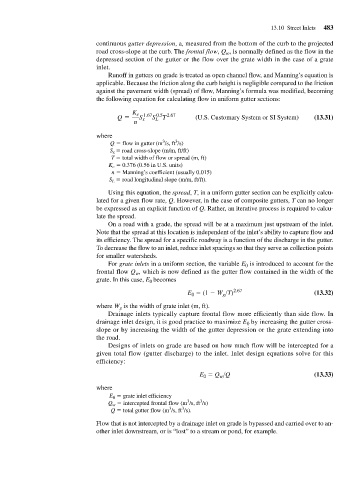Page 525 - Fair, Geyer, and Okun's Water and wastewater engineering : water supply and wastewater removal
P. 525
JWCL344_ch13_457-499.qxd 8/7/10 8:49 PM Page 483
13.10 Street Inlets 483
continuous gutter depression, a, measured from the bottom of the curb to the projected
road cross-slope at the curb. The frontal flow, Q , is normally defined as the flow in the
w
depressed section of the gutter or the flow over the grate width in the case of a grate
inlet.
Runoff in gutters on grade is treated as open channel flow, and Manning’s equation is
applicable. Because the friction along the curb height is negligible compared to the friction
against the pavement width (spread) of flow, Manning’s formula was modified, becoming
the following equation for calculating flow in uniform gutter sections:
K e 1.67 0.5 2.67
Q = S x S L T (U.S. Customary System or SI System) (13.31)
n
where
3
3
Q flow in gutter (m /s, ft /s)
S x road cross-slope (m/m, ft/ft)
T total width of flow or spread (m, ft)
K c 0.376 (0.56 in U.S. units)
n Manning’s coefficient (usually 0.015)
S L road longitudinal slope (m/m, ft/ft).
Using this equation, the spread, T, in a uniform gutter section can be explicitly calcu-
lated for a given flow rate, Q. However, in the case of composite gutters, T can no longer
be expressed as an explicit function of Q. Rather, an iterative process is required to calcu-
late the spread.
On a road with a grade, the spread will be at a maximum just upstream of the inlet.
Note that the spread at this location is independent of the inlet’s ability to capture flow and
its efficiency. The spread for a specific roadway is a function of the discharge in the gutter.
To decrease the flow to an inlet, reduce inlet spacings so that they serve as collection points
for smaller watersheds.
For grate inlets in a uniform section, the variable E is introduced to account for the
0
frontal flow Q , which is now defined as the gutter flow contained in the width of the
w
grate. In this case, E becomes
0
E (1 W >T) 2.67 (13.32)
g
0
where W is the width of grate inlet (m, ft).
g
Drainage inlets typically capture frontal flow more efficiently than side flow. In
drainage inlet design, it is good practice to maximize E by increasing the gutter cross-
0
slope or by increasing the width of the gutter depression or the grate extending into
the road.
Designs of inlets on grade are based on how much flow will be intercepted for a
given total flow (gutter discharge) to the inlet. Inlet design equations solve for this
efficiency:
E Q >Q (13.33)
0
w
where
E 0 grate inlet efficiency
3
3
Q w intercepted frontal flow (m /s, ft /s)
3
3
Q total gutter flow (m /s, ft /s).
Flow that is not intercepted by a drainage inlet on grade is bypassed and carried over to an-
other inlet downstream, or is “lost” to a stream or pond, for example.

